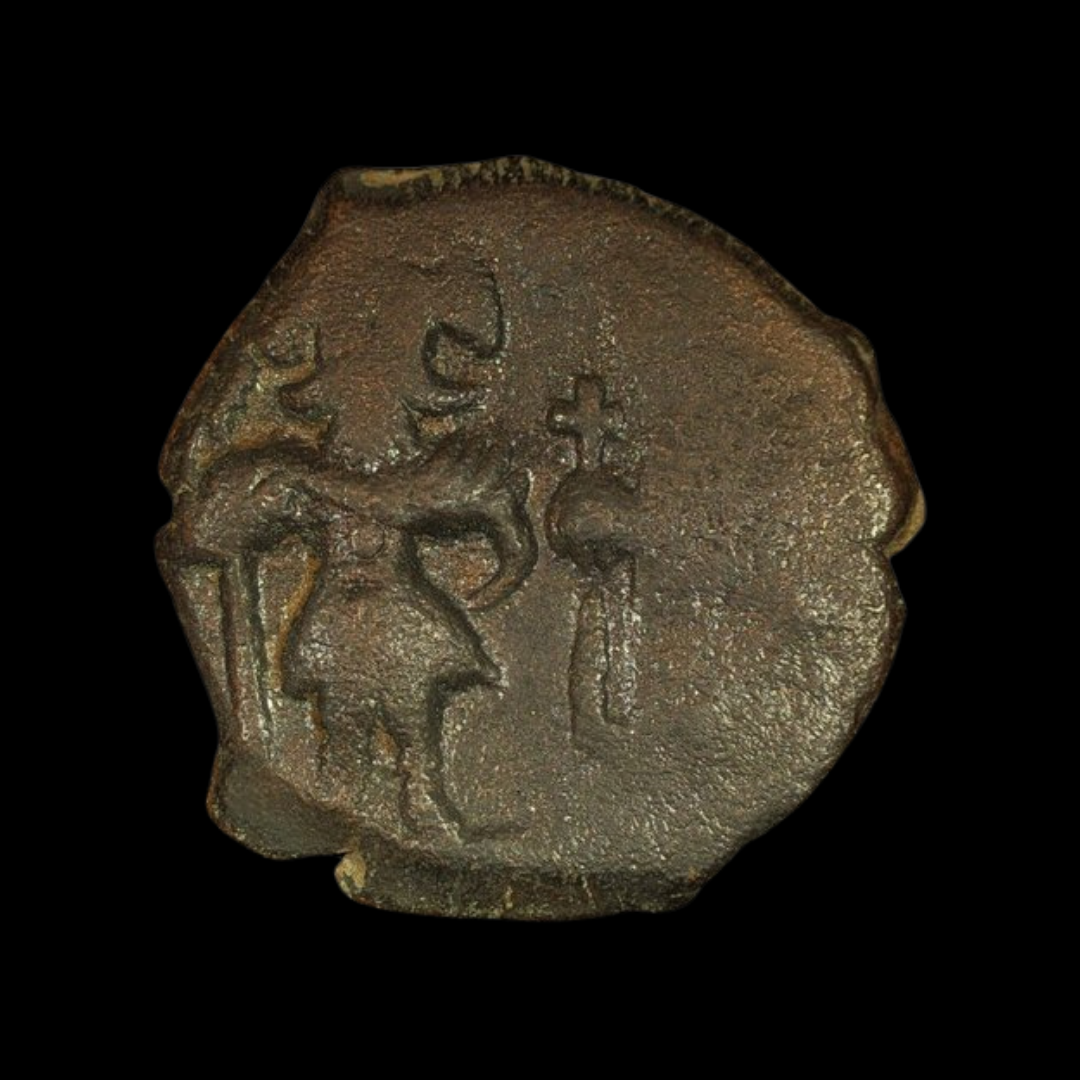 Image 1 of 2
Image 1 of 2

 Image 2 of 2
Image 2 of 2



Byzantine Follis of Justinian I (about 1500 years ago)
This substantial bronze coin was minted in Constantinople (modern Istanbul, Turkey) during the early reign of Justinian I, one of the most significant Byzantine emperors. The large bronze follis was part of Justinian's monetary reforms aimed at stabilizing the economy of the Eastern Roman Empire.
Coin Description:
Front side: Helmeted and armored bust of Justinian I facing forward, holding cross on globe and shield, with Latin inscription "DN IVSTINI-ANVS PP AVC" (Our Lord Justinian, Father of the Country, Augustus)
Back side: Large letter M (Greek numeral for 40) between "ANNO" and "XII" (Year 12); cross above; mint mark "CON" (Constantinople) in exergue (bottom section)
Technical Details:
Bronze composition (weighing 19.07 grams)
Follis denomination (40 nummi, a common Byzantine bronze coin)
References: Berk-217, DO-37c, MIB-95
No certification mentioned
Date: 523/9 CE (12th year of reign)
Condition: Not specified
Historical Significance:
This coin was struck during the early reign of Emperor Justinian I, shortly before he would launch his ambitious campaign to reconquer the lost western provinces of the Roman Empire. The Byzantine Empire (Eastern Roman Empire) was entering its golden age, with Constantinople (modern Istanbul) serving as the wealthiest city in the Mediterranean world. The prominent Christian symbolism on the coin reflects how Christianity had become central to imperial identity, while the use of Latin inscriptions maintained continuity with Roman tradition.
This substantial bronze coin was minted in Constantinople (modern Istanbul, Turkey) during the early reign of Justinian I, one of the most significant Byzantine emperors. The large bronze follis was part of Justinian's monetary reforms aimed at stabilizing the economy of the Eastern Roman Empire.
Coin Description:
Front side: Helmeted and armored bust of Justinian I facing forward, holding cross on globe and shield, with Latin inscription "DN IVSTINI-ANVS PP AVC" (Our Lord Justinian, Father of the Country, Augustus)
Back side: Large letter M (Greek numeral for 40) between "ANNO" and "XII" (Year 12); cross above; mint mark "CON" (Constantinople) in exergue (bottom section)
Technical Details:
Bronze composition (weighing 19.07 grams)
Follis denomination (40 nummi, a common Byzantine bronze coin)
References: Berk-217, DO-37c, MIB-95
No certification mentioned
Date: 523/9 CE (12th year of reign)
Condition: Not specified
Historical Significance:
This coin was struck during the early reign of Emperor Justinian I, shortly before he would launch his ambitious campaign to reconquer the lost western provinces of the Roman Empire. The Byzantine Empire (Eastern Roman Empire) was entering its golden age, with Constantinople (modern Istanbul) serving as the wealthiest city in the Mediterranean world. The prominent Christian symbolism on the coin reflects how Christianity had become central to imperial identity, while the use of Latin inscriptions maintained continuity with Roman tradition.
This substantial bronze coin was minted in Constantinople (modern Istanbul, Turkey) during the early reign of Justinian I, one of the most significant Byzantine emperors. The large bronze follis was part of Justinian's monetary reforms aimed at stabilizing the economy of the Eastern Roman Empire.
Coin Description:
Front side: Helmeted and armored bust of Justinian I facing forward, holding cross on globe and shield, with Latin inscription "DN IVSTINI-ANVS PP AVC" (Our Lord Justinian, Father of the Country, Augustus)
Back side: Large letter M (Greek numeral for 40) between "ANNO" and "XII" (Year 12); cross above; mint mark "CON" (Constantinople) in exergue (bottom section)
Technical Details:
Bronze composition (weighing 19.07 grams)
Follis denomination (40 nummi, a common Byzantine bronze coin)
References: Berk-217, DO-37c, MIB-95
No certification mentioned
Date: 523/9 CE (12th year of reign)
Condition: Not specified
Historical Significance:
This coin was struck during the early reign of Emperor Justinian I, shortly before he would launch his ambitious campaign to reconquer the lost western provinces of the Roman Empire. The Byzantine Empire (Eastern Roman Empire) was entering its golden age, with Constantinople (modern Istanbul) serving as the wealthiest city in the Mediterranean world. The prominent Christian symbolism on the coin reflects how Christianity had become central to imperial identity, while the use of Latin inscriptions maintained continuity with Roman tradition.
Justinian I (/dʒʌˈstɪniən/ just-IN-ee-ən; Latin: Iūstīniānus, Classical Latin pronunciation: [juːstiːniˈaːnʊs]; Ancient Greek: Ἰουστινιανός, romanized: Ioustinianós, Byzantine Greek pronunciation: [i.ustini.aˈnos]; 482 – 14 November 565),[b] also known as Justinian the Great,[c] was the Roman emperor from 527 to 565.
His reign was marked by the ambitious but only partly realized renovatio imperii, or "restoration of the Empire".[5] This ambition was expressed by the partial recovery of the territories of the defunct Western Roman Empire.[6] His general, Belisarius, swiftly conquered the Vandal Kingdom in North Africa. Subsequently, Belisarius, Narses, and other generals conquered the Ostrogothic Kingdom, restoring Dalmatia, Sicily, Italy, and Rome to the empire after more than half a century of rule by the Ostrogoths. The praetorian prefect Liberius reclaimed the south of the Iberian Peninsula, establishing the province of Spania. These campaigns re-established Roman control over the western Mediterranean, increasing the Empire's annual revenue by over a million solidi.[7] During his reign, Justinian also subdued the Tzani, a people on the east coast of the Black Sea that had never been under Roman rule before.[8] He engaged the Sasanian Empire in the east during Kavad I's reign, and later again during Khosrow I's reign; this second conflict was partially initiated due to his ambitions in the west.










